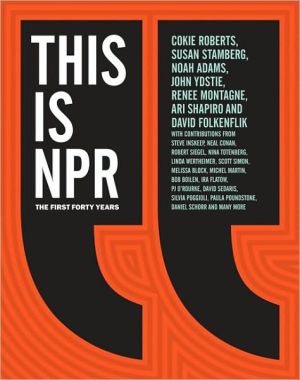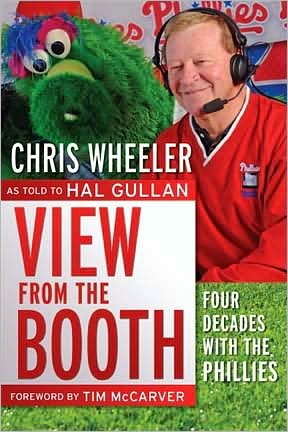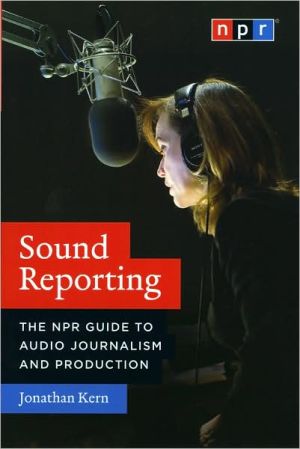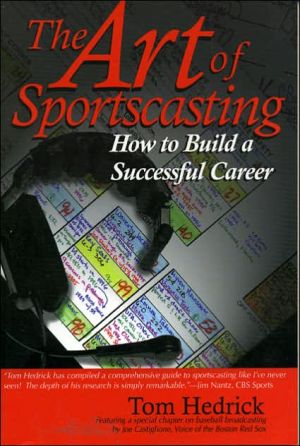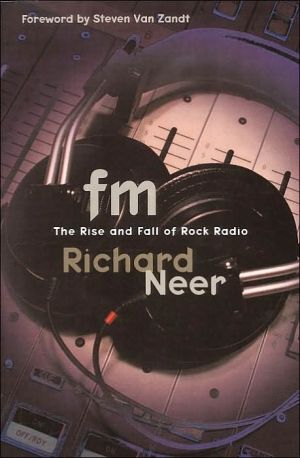King Football: Sport and Spectacle in the Golden Age of Radio and Newsreels, Movies and Magazines, the Weekly and the Daily Press
This landmark work explores the vibrant world of football from the 1920s through the 1950s, a period in which the game became deeply embedded in American life. Though millions experienced the thrills of college and professional football firsthand during these years, many more encountered the game through their daily newspapers or the weekly Saturday Evening Post, on radio broadcasts, and in the newsreels and feature films shown at their local movie theaters. Asking what football meant to...
Search in google:
This landmark work explores the vibrant world of football from the 1920s through the 1950s, a period in which the game became deeply embedded in American life. Though millions experienced the thrills of college and professional football firsthand during these years, many more encountered the game through their daily newspapers or the weekly Saturday Evening Post, on radio broadcasts, and in the newsreels and feature films shown at their local movie theaters. Asking what football meant to these millions who followed it either casually or passionately, Michael Oriard reconstructs a media-created world of football and explores its deep entanglements with a modernizing American society. Football, claims Oriard, served as an agent of "Americanization" for immigrant groups but resisted attempts at true integration and racial equality, while anxieties over the domestication and affluence of middle-class American life helped pave the way for the sport's rise in popularity during the Cold War. Underlying these threads is the story of how the print and broadcast media, in ways specific to each medium, were powerful forces in constructing the football culture we know today. Sandy Padwe When it comes to explaining why football—in partnership with complacent and compliant media—has become such a dominant cultural force in American society, Michael Oriard is unsurpassed.
King Football\ Sport and Spectacle in the Golden Age of Radio and Newsreels, Movies and Magazines, the Weekly and the Daily Press \ \ By Michael Oriard \ The University of North Carolina Press\ Copyright © 2001 University of North Carolina Press\ All right reserved.\ ISBN: 978-0-8078-2650-8 \ \ \ \ Introduction\ In 1932, a book titled King Football indicted the big-time intercollegiate sport for commercialism, anti-intellectualism, distorted priorities, fraud, hypocrisy-the full range of charges currently in the air. The author was Reed Harris, who had been the editor of Columbia University's campus newspaper until March of that year, when the administration expelled him for his attacks on various university practices including its sponsorship of a big-time football team. Harris was reinstated on appeal (after a student strike and intervention by the Civil Liberties Union) but declined the privilege and wrote King Football instead. \ A few years later, another radical critic, James Wechsler, appropriated Harris's title for discussing the sport in his own book about student militancy and administrative repression. Wechsler was sympathetic to football players, who toiled for little pay, but he despised the institutionalized game as a reactionary force on campus. For Harris and Wechsler, "King Football" was a vulgar, bloated, mead-swilling pretender.\ For the editors of the pulp magazine Sport Story, welcoming the 1932 season with a hearty "Hail, King Football!" His Majesty was a jolly and benign ruler, presiding over three months of festivity. This was the majority viewpoint. An article in 1933 in the Literary Digest by the New York Sun's George Trevor worried about how "King Football" was faring in the Depression. The following season, a six-column cartoon in the Portland Oregonian captured the merry monarch in all his gaiety-"Here Comes King Football, the Popular Old Rascal, to Demand the Attention That Is His Due This Time of Year"-as did the program for the Ohio State-NYU game in 1936.\ By 1938, "King Football" was among the clichés of the sport satirized by a writer in the Atlantic Monthly, but the sportive monarch easily survived such mockery. An editorial in the 1939 inaugural issue of Football News joyfully proclaimed, "At this time of year we look to King Football to wear the crown in his royal manner." A history of the sport in a magazine published by the Dow Chemical Company in 1947 had the title "King Football." His Highness still ruled as late as 1963, when a history of the high school sport celebrated the rise of "King Football in Texas."\ The Reign of "King Football"\ My book is a study of "King Football" from the 1920s through the 1950s, a period mostly marked by the enthusiasm of the editors of Sport Story and the Football News, but rarely without the censure of a Reed Harris or James Wechsler. My underlying question will be a simple one: what did football mean to the actual millions who followed it, whether casually or passionately, during this period? The book continues an investigation I began several years ago in Reading Football: How the Popular Press Created an American Spectacle. Football was born on college campuses in the Northeast in the 1870s and reached its first maturity, its acceptance as a spectator sport, by the 1890s. Popularity by no means meant unambivalent embrace, however; football's early decades were marked by hyperbolic condemnation as well as praise. Controversies over "professionalism," "overemphasis," and, above all, brutality provoked periodic efforts at reform, culminating in major revisions of playing rules and institutional practices in 1906, 1910, and 1912. Having begun as a version of rugby, American football developed in the 1880s and 1890s along the lines of infantry warfare, as the first generation of coaches devised various strategies for massing the offensive attack on a vulnerable point in the defensive line. What pleased coaches appalled critics of the resulting mayhem and, more pragmatically important for football's future, risked boring its newly won fans. Those fans were drawn to the game, in large part, by the sensationalized coverage in their daily newspapers, inaugurated by Joseph Pulitzer and his rivals in New York who created the modern newspaper. With the game uneasily established as both an extracurricular activity and a great public spectacle, the rule makers opened up play, most significantly by legalizing the forward pass, and largely completed the transformation of American football from its rugby beginnings to the game we know today.\ Football thus reached its second maturity on the eve of the Great War in Europe. A handful of schools had dropped the sport for its brutality, and Cal, Stanford, and some other West Coast universities had briefly abandoned American football for the less-brutal rugby version, but otherwise intercollegiate football was now played throughout the country, and high schools everywhere were adopting the collegians' game. Professional football had as yet no formal organization or even social acceptance, but former college stars had played for pay as "ringers" on athletic club teams since 1892, and by the early 1900s professional teams were forming in many midwestern towns.\ The outbreak of war interrupted football's development, only to spur it to greater growth afterward. Football's "Big Three," Harvard, Yale, and Princeton, were among the colleges that suspended their football programs as the United States was drawn into the conflict, while others scaled back and the game's promotional engines were geared down. Walter Camp named no All-America team for 1917, and the Rose Bowl in 1918 and 1919 featured service teams instead of collegians. But the war also turned out to be an impetus to the tremendous growth of football in the 1920s. Walter Camp helped organize a service-football program that introduced the game to thousands of young men. An editorial in the New York Times in 1919 declared that "football owes more to the war in the way of the spread of the spirit of the game than it does to ten or twenty years of development in the period before the war." Equally significant, one of the greatest shocks war brought to educational leaders was the discovery that as a nation we were physically deficient. During the war, patriotic articles in such magazines as American Boy declared that the American system of school athletics trained young men in discipline, courage, teamwork, endurance, and other qualities necessary to soldiers. Following the armistice, however, General Leonard Wood reported that half the American men drafted had been unfit for service. An avalanche of calls followed for mandatory physical education and for intramural and interscholastic athletic programs. Historians point to this "preparedness crisis" as an important context for the renewed emphasis on rugged sports as Americans returned to peacetime pursuits. Concern over the country's physical health, at the same time the economy was booming, leisure time was expanding, and the marketing of a new consumption ethic went into high gear, helped generate the sporting explosion of the 1920s.\ King Football picks up the story at this point. His majesty's reign began in the years between the two World Wars, when football underwent tremendous growth at all levels. In 1920, both a National Federation of State High School Athletic Associations and the organization that became the National Football League were formed. In that year, just 16.8 percent of Americans finished high school, but as that figure increased to nearly 50 percent by 1940, football became a basic part of high school life. By 1923, 91 percent of high schools in one survey had football teams, and in forty-five of forty-eight states the teams belonged to the statewide interscholastic leagues and athletic associations that have continued to this day. Newspaper coverage of high school football grew as well. Weekly column-inches of interscholastic sport coverage in the New York Times increased from about 200 at the turn of the century to almost 1,000 by the First World War, then shot up to nearly 3,200 by 1926; that expansion played out in other newspapers as well. By the early 1930s, high school coaches were torn between the welcome impact and adverse effects of newspaper publicity: while it helped to boost attendance and gate receipts, the added attention could also negatively affect the impressionable boys who played the game. The largest crowds for scholastic football watched the Catholic vs. Public league championships in Chicago and Philadelphia, and benefit games such as the PTA Milk Fund Carnival in Los Angeles, but the fiercest passions were likely aroused by the more routine contests played by the teams from rival towns all over the country. By the end of the 1930s, even the smallest rural high schools could field teams, through the invention of six-man football by a high school teacher in Hebron, Nebraska.\ The National Football League was born, as the now well-told story has it, in the office of an auto agency in Canton, Ohio, when the representatives from a handful of midwestern professional clubs formed the American Professional Football Conference. What became the NFL in 1922 was strictly an industrial and milltown league, with transient teams and transient players, scorn from amateur purists, and indifference from the larger public. Apathy briefly turned to fascination in 1925, when Red Grange joined the Chicago Bears immediately following his final college game for the University of Illinois. Crowds instantly swelled to see the most famous football player in the land-the Galloping Ghost, the Wheaton Ice Man-but even Grange could not sustain interest in a football league to which most of the country felt no connection. The reorganization of the NFL in 1933 into its current structure of big-city clubs in two divisions, their leading teams playing for a national championship, launched professional football on its slow ascent to the pinnacle of American spectator sports.\ Pro football paid poorly, attracting mostly collegians who could do no better in the depressed job market of the 1930s, but it was sufficiently profitable for owners to attract rival leagues. The NFL's first organized opposition was the American Football League, formed in 1926 by Grange and his agent, C. C. Pyle; it lasted but one year. A second and third incarnation of the AFL each survived two seasons, 1936-37 and 1940-41, again with negligible impact on the NFL. The fourth rival league, the All-America Football Conference (1946-49), was considerably more consequential, temporarily escalating salaries and contributing three teams (the Cleveland Browns, San Francisco 49ers, and Baltimore Colts) to a restructured NFL. By this time, the New York Giants and Chicago Bears had become the principal football teams in the country's two largest cities, but it was not until the coming of television after World War II that the professional game could reach, and hold, a national audience.\ Among the pros who became major stars with the coming of television in the postwar era, a disproportionate number were African American. This development followed what had been an unofficial but absolute ban on black players from 1934 through 1945, apparently demanded by the owner of the Boston (later Washington) Redskins, George Preston Marshall. Black stars of the 1930s such as Iowa's Oze Simmons and UCLA's Kenny Washington graduated from college football to minor professional leagues on the East or West Coast, not to the Giants or Bears. Reintegration was provoked by two factors in 1946: pressure on the Los Angeles Rams from local black leaders, who threatened to block the team's lease of the Los Angeles Coliseum; and the challenge of the All-America Football Conference, whose Cleveland Browns immediately signed two black future Hall of Famers, Bill Willis and Marion Motley, and dominated professional football over the next decade with conspicuously integrated teams. NFL clubs gradually integrated over the late 1940s and 1950s, with the Washington Redskins holding out until 1962. By this time, professional football was a truly national sport, with a huge and growing TV audience; the sudden-death overtime championship game in 1958 is usually recognized as a turning point in the public's embrace of pro football through television.\ However significant the expansion of high school football and the birth, then restructuring, of a major professional league, it was the growth of college football into a spectator sport to rival major league baseball that most importantly marks the years between the two world wars. Given the relatively low percentage of Americans who attended college-8 percent of 18-21 year olds in 1920, increasing only to 12 percent in 1930, a little less than 16 percent in 1940 (still not quite 30 percent in 1950, despite the thousands attending on the GI Bill)-college football's broad appeal is remarkable. Attendance at college football games increased 119 percent in the 1920s, exceeding 10 million by the end of the decade, slightly more than for major league baseball. Both as cause and effect of the tremendous new enthusiasm for football, a stadium-building boom in the 1920s planted huge concrete and brick bowls in landscapes throughout the Midwest, South, and Far West in the 1920s. By 1930 there were seventy-four concrete stadiums, fifty-five of them built since 1920, six of them with a seating capacity exceeding 70,000, including the Rose Bowl in Pasadena (1922), the Los Angeles Coliseum (1923), and Soldier Field in Chicago (1924). About 60 percent of the attendance at college football came from some forty institutions whose teams played in these massive structures. Eight Big Ten universities built or expanded their football stadiums in the 1920s, including Illinois's 67,000-seat Memorial Stadium, whose formal dedication in 1924 was marked by Red Grange's astonishing six-touchdown performance against Michigan. That game became an instant legend because of the occasion, the size of the crowd, and the unusually large presence of the media-all the elements, that is, of football as media spectacle-now in place for the first time.\ Before the age of television, football was fundamentally local-"our boys" against all others-and what college football offered fans that professional and high school football could not was a local team competing in a national arena. As football teams became public symbols of universities, communities, and entire regions in a hugely publicized national drama, intersectional games and postseason bowl games proliferated in the 1920s and 1930s. The upset of Harvard in 1921 by tiny Centre College made the unthinkable seem possible for every football team with ambitions; Notre Dame, an insignificant Catholic college transformed into a national phenomenon, became the model for university-building through the football team. Football power shifted westward in the 1920s and southward in the 1930s. Football regions became defined by major conferences: the Western (Big Ten), Pacific Coast, Southeastern, Southwest, and Big Six, more or less in that order of descending prestige. The East remained loosely confederated, with the Big Three of Harvard, Yale, and Princeton maintaining their preeminence as football's founders even as their football prowess waned. The Rose Bowl, which served as an unofficial East-West championship game in the 1920s, had to share New Year's Day with the Orange Bowl beginning in 1933, then the Sugar Bowl in 1935 and the Cotton Bowl in 1937. They were soon joined by dozens more as promoters throughout the Sun Belt sought to cash in, until the NCAA stepped in to regulate the bowl games in the 1950s.\ The drama of each season played out in weekly episodes, as hundreds of teams battled for regional and national honors, and a new set of heroes held the public's attention for a few months; but each season was also attended by major or minor controversies deriving from that inextricable mixing of sport and promotion out of which big-time football was born. The Carnegie Foundation's report in 1929 on the widespread recruiting and subsidizing of athletes in a so-called amateur game undoubtedly provoked soul-searching in many university administrators, but its impact was blunted by indifference and outright resistance from the general public and the sportswriters whose columns they read. The elements of "professionalism" denounced by the Carnegie report eventually became standard practices, but not before three more decades of wrangling over the ethics of college football, with economics trumping ethics at each step along the way. Harvard, Yale, and Princeton, along with Penn, Cornell, Brown, Columbia, and Dartmouth, agreed in 1945 to a "deemphasized" brand of football, initially dropping scholarships, then in 1952 banning spring practice and bowl games as well, finally in 1956 officially becoming the Ivy League. The Big Three, who taught the rest of America's colleges all the tricks of highly professionalized football, changed course, while King Football continued to rule elsewhere in the same old merry way.\ (Continues...)\ \ \ \ \ Excerpted from King Football by Michael Oriard Copyright © 2001 by University of North Carolina Press. Excerpted by permission.\ All rights reserved. No part of this excerpt may be reproduced or reprinted without permission in writing from the publisher.\ Excerpts are provided by Dial-A-Book Inc. solely for the personal use of visitors to this web site. \ \
PrefaceIntroduction1Pt. IIn the Kingdom of FootballCh. 1Reading, Watching, and Listening to Football23Ch. 2Local Football65Ch. 3Who Cares about Reform?101Ch. 4Players' or Coaches' - Whose Game Is It?126Ch. 5Gridiron, U.S.A.162Ch. 6Sanctioning Savagery199Pt. IIWhat We Think About When We Think About FootballCh. 7Class?225Ch. 8Ethnicity255Ch. 9Race283Ch. 10Masculinity328Epilogue: Into the Age of Television364App. AFootball Films, 1920-1960371App. BFootball Covers on the Saturday Evening Post and Collier's, 1920-1960374App. CFootball Fiction in the Saturday Evening Post and Collier's, 1920-1960378Notes383Bibliography435Index471
\ Sandy PadweWhen it comes to explaining why football—in partnership with complacent and compliant media—has become such a dominant cultural force in American society, Michael Oriard is unsurpassed.\ \ \ \ \ Murray SperberKing Football is a wonderful book, essential reading for anyone interested in this uniquely American phenomenon.\ \ \ USA TodayFor the fan with a scholarly bent.\ \ \ \ \ Library JournalHaving examined football from the late 19th to the early 20th centuries in Reading Football: How the Popular Press Created an American Spectacle, Oriard (American literature and culture, Oregon State Univ.), a former player for Notre Dame and the Kansas City Chiefs, here looks at the game from the 1920s through the 1950s. During this period, Americans followed their favorite college or professional team in newspapers, magazines, and newsreels or by listening to the radio, and Oriard shows that the media were a powerful force in constructing the football culture we know today. He also shows how football culture reflects broader changes in U.S. society. The volume includes an exhaustive bibliography and notes, plus appendixes on football films and football cover images on the Saturday Evening Post/Collier magazines from 1920 to 1960. A book football enthusiasts will enjoy, this is recommended for all libraries where demand warrants. Larry R. Little, Penticton P.L., BC Copyright 2001 Cahners Business Information.\ \ \ \ \ From the Publisher"A book football enthusiasts will enjoy, this is recommended for all libraries. (Library Journal)"\ "When it comes to explaining why football—in partnership with complacent and compliant media—has become such a dominant cultural force in American society, Michael Oriard is unsurpassed. (Sandy Padwe, Graduate School of Journalism, Columbia University)"\ "King Football is a wonderful book, essential reading for anyone interested in this uniquely American phenomenon. (Murray Sperber, author of Beer and Circus: How Big-Time College Sports Is Crippling Undergraduate Education)"\ \ \


